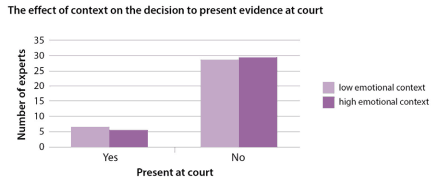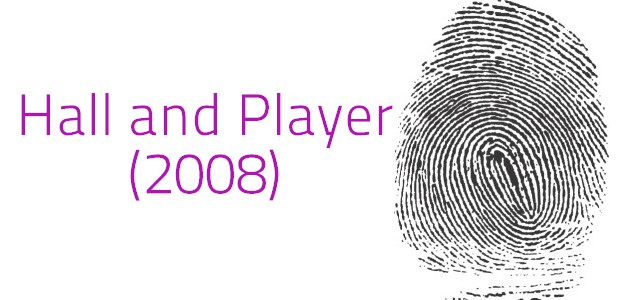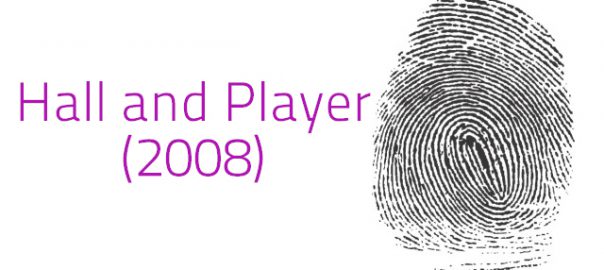Hall, L. J., & Player, E. (2008). Will the introduction of an emotional context affect fingerprint analysis and decision-making?. Forensic Science International, 181(1), 36-39.
Background
This is a study you may need for your OCR H567, Applied Psychology exam. It is from the criminal psychology unit. It considers the topic: The collection and processing of forensic evidence (biological). The application for this study is at least one strategy for reducing bias in the collection and processing of forensic evidence.
For this criminal psychology unit, it is highly recommended that you read Forensic Psychology: A Very Short Introduction (Very Short Introductions) to gain a deeper understanding of criminal psychology.
It is accepted that an expert in any discipline, as opposed to a novice, is able to demonstrate their increased competencies and cognitive processing skills, which have been enhanced with extensive training and practice. It is often said ‘that practice makes perfect’.
The analysis and comparison of fingerprints relies on the ability of an individual to recognise the differences or similarities between the ridge details of a finger mark obtained from a crime scene with one taken from a suspect. The process is open to the questioning of an expert’s ability to accurately analyse and interpret friction ridges. It has been suggested that the interpretation and analysis of finger marks becomes more subjective as clarity decreases and as a consequence the expert is more vulnerable to external stimuli.
There are parallels between the behavioural adaptations and interpretive skills of fingerprint expertise and expertise in other fields. Studies on expert radiologists demonstrated that they have developed high-visual efficiency. They were able to select, apply and modify appropriate schemata (a collection of postulates based on past experiences) allowing them to interpret images more efficiently than the novice radiologists (Haller and Radue, 2005). These past experiences and observations may lead to the creation of an internal database or framework for organising relevant knowledge.
Neurophysiological research has revealed that certain areas of the brain are able to appoint an emotional meaning to an environmental stimulus, which triggers a response and could impact on decision-making (Vicente, 1998).
Experimental research suggests that emotional effects based on external stimuli; do impact on decision making processes during the examination of fingerprints Dorr et al., 2005).
In the United Kingdom the training of a fingerprint expert involves a structured programme of formal courses, which tutor and assess a series of competencies, including the scientific theories of foetal fingerprint development and the factors that give rise to their observed individuality; methods for the recovery of latent finger marks; applied examination techniques, utilising Analysis, Comparison, Evaluation and Verification (ACE-V) methodology. The practitioner then utilises these competencies through practical work experience. During their progression to ‘expert’ status the practitioner’s work is constantly peer reviewed and assessed. The training process requires the achievement and demonstration of competence before a practitioner is deemed proficient to give fingerprint evidence in a court of law. It is accepted that an expert in any discipline, as opposed to a novice, is able to demonstrate their increased competencies and cognitive processing skills, which have been enhanced with extensive training and practice.
In many cases the marks available from a crime scene are far from ideal. The marks may be incomplete, smudged, distorted, rotated or may be obscured by the substrate. In order to secure quality, it is standard operating procedure for the identification process to be conducted independently by at least two fingerprint experts.
It has been suggested that the circumstances surrounding a crime case and the pressure experts are put under to produce results may influence the reported outcome (Risinger et al., 2002).
Dorr et al., 2005, gave university research students either good quality or incomplete, poor quality fingerprints to study. They were also given emotional stimuli deemed low level (case details pertaining to a theft) or high level (case details pertaining to a murder). The latter was accompanied by disturbing photographic images of the victim. Some volunteers were also subjected to subliminal messages stating ‘guilty’ or the ‘‘same’’, during their initial analysis. The results showed that the volunteers were affected by the emotional context and this interfered with their decisions, making them more likely to make matches or identifications when analysing poor quality or ambiguous pairs of fingerprints. This research raised the following questions:
- Would the same results be found with trained fingerprint experts?
- Are misidentifications made due to emotional bias?
The protocol employed by the Metropolitan Police Service for the identification of fingerprints involves providing the fingerprint examiner with a copy of the crime scene examination report, which details the nature of the crime but it does not provide any photographic images of the crime scene. Hall and Player thought it was important to ascertain if the normal working practices employed by the Metropolitan Police Fingerprint Bureau introduce an emotional bias.
Aim
Hall and Player (2008) aimed to test if context had an effect on fingerprint identification by fingerprint experts.
Hall and Player (2008) specifically attempted to answer the following research questions:
- Does the written report of a crime, as routinely supplied with the fingerprint evidence, affect a fingerprint expert’s interpretation of a poor quality mark? (This was addressed in the study through the analysis of an artificially obscured fingerprint.)
- Are the fingerprint experts emotionally affected by the circumstances of the case? (This was addressed in the study by a specially devised feedback questionnaire.).
Method and Design
This was a laboratory experiment. Although designed to be as naturalistic as possible with participants being asked to participate in work time, in a typical fingerprint examination room within the New Scotland Yard Fingerprint Bureau, the task itself was artificially generated and participants were randomly allocated to one of two conditions. Furthermore, some control over the experimental conditions was preferred as in a naturalistic setting there would be no capacity to prevent the experts from asking each other’s opinions.
The independent variable (IV) was whether the participant was allocated to the low-context or the high-context group.
The dependent variables (DVs) were:
- Whether the participant read the crime scene examination report prior to examining the fingerprint
- Whether the participant considered the finger mark was (i) identification – a match, (ii) not an identification – not a match, (iii) insufficient – not enough detail to undertake a comparison, (iv) insufficient detail to establish identity, some detail in agreement but not enough to individualise
- Whether the participant would be confident to present the fingerprint as evidence at court.
The experiment used an independent measures design.
Sample and Sampling Method
The participants were all respondents to a request for volunteers to take part in an experiment. The request did not go into the details of the experiment. Therefore this study used a volunteer sample.
A group of fingerprint practitioners, chosen to represent a wide variation of experience.
70 fingerprint experts working for the Metropolitan Police Fingerprint Bureau took part. Their length of experience as experts ranged from less than three months to over 30 years.
The mean length of experience was 11 years.
The majority had volunteered and were active practitioners working on fingerprint teams, dealing with crimes that ranged from burglaries and motor vehicle theft through to homicide and terrorism.
A minority of participants (12 in total) had managerial roles and although they were still on the United Kingdom National Register of fingerprint experts, they were no longer active practitioners.
The low context group had 35 participants.
The high-context group had 35 participants.
Materials
In order to validate the decisions of the experts, a finger impression from a known source was used. A volunteer’s right forefinger was inked and introduced to a piece of paper. This good quality clear mark was then scanned on to a computer and super-imposed on a scanned image of a £50 note.
The finger mark was positioned so the background of the note obscured the majority of the ridge detail.
The mark was then manipulated to control the contrast and further obscure the discernible detail within the finger mark. Fourteen copies of this mark were then printed for use in the experiment.
The images used were of actual size and the colour, size and detail of the image contained on the card were representative of the quality and clarity received on a regular basis.
All 14 copies of the mark were then compared against each other to ensure consistency. – The finger mark and the corresponding set of fingerprint impressions (all 10- printed fingers, donated by the same source as the mark) were then given to participants who were asked to give their expert opinions as to whether there was a match using the procedure outlined below.
Each participant was allowed access to a fingerprint magnifying glass and a Russell comparator (an optical magnifying unit for comparing two images).
Procedure
In order to create an environment that was as naturalistic as possible for the volunteers, they were all asked to participate in work time, and a typical fingerprint examination room within the New Scotland Yard Fingerprint Bureau was used for the experiment.
The volunteers were randomly assigned in groups of eight and were asked to treat the experiment as they would a typical day, they could come and go as they pleased, and talk among themselves as long as they did not discuss the finger marks that they were analysing in the experiment, or the experiment itself. No time limit was placed on the participants and they were told to consider the experiment material as an ordinary case.
The participants were assigned into one of two groups, low-emotional context or high-emotional context, on the day of the experiment.
The low-context group (35 participants) was given an examination report referring to an allegation of forgery. This was chosen as it is considered a victimless crime and carries a relatively minor sentence. The modus operandi stated that a ‘‘Suspect entered premises and tried to pay for goods with a forged £50 note. The forgery was spotted by cashier. Suspect then decamped’’ i.e. left the scene.
The high-context group (35 participants) was given an examination report referring to an allegation of murder. This was chosen because there is, inevitably, a victim and it carries the most severe sentence. The final wording on the examination report was altered to read ‘‘Suspect then fired two shots at victim before decamping’’ (leaving the scene).
One of the researchers stayed with each group at all times to answer any questions.
The participants completed a demographic information sheet, detailing where they worked, how many years experience as an expert they had and whether they had presented evidence at court.
The research was conducted anonymously and all candidates were given a unique reference number to endorse each of their question sheets.
The participants were given an envelope containing one of the test marks, the relevant 10-print fingerprint form, the relevant scene examiner’s examination report and a sheet of paper advising participants of the contents which also stated that the mark was made by the right forefinger. These were all typical case reports that a fingerprint expert may receive when given a finger mark to study for the first time, except for the paper advising participants that the mark was made by the right forefinger which was only included to save time so the experts could get straight into the analysis, rather than spend time making comparisons. (This process replicated the verification stage of the identification process, where the initial examiner, who may not be a fully qualified fingerprint expert, annotates the documentation with their decisions, directing the verifier to the area of ridge detail that they have concluded is a match or is insufficient to establish identity. The verifier may agree or disagree with this initial conclusion).
The experts were then asked to consider whether the mark was:
- identification (a match)
- not an identification (not a match)
- insufficient—not enough detail to undertake a comparison,
- insufficient detail to establish identity, some detail in agreement but not enough to individualise.
They were also asked to elaborate on their findings by providing observations and opinions.
Finally, when they had finished the experiment, they were given a feedback sheet which asked whether or not they had referred to the crime scene examination report prior to their assessment of the marks and to indicate what information they had read, i.e. the allegation, modus operandi, date, venue, victim and the details of examination. If they had referred to the crime scene examination report they were also asked whether, in their own judgment, they felt that the information contained on the examination report had affected their analysis and if so how?
Results
A total of 57 of the 70 participants (81.4%) indicated that they had read the crime scene examination report prior to examining the prints. 30 of the 57 were in the high-context scenario group showing that 52.6%) compared to 27 (47.4%) of the low-context group.
Therefore 18.6 (19%) of experts stated on their feedback forms that they did not read the crime scene examiner’s report presented with the finger marks (so were unaware of the crime type context when making their judgements).
52% of the 30 who had read the high-context scenario felt that they were affected by the information given on the examination report which is significantly greater than the 6% who had read and reported that they were affected by the low-context scenario.
This indicates that there is a relationship between the type of context and the perceived effect on the experts.
To establish whether this perceived effect altered the final decision of the expert, the difference between the decisions made between the two groups was compared. These findings are displayed in the table below.
The experts’ final opinions of the finger mark comparison for the low and high contexts:

The table shows the final decisions made by the experts to be very similar regardless of the emotional context. Chi-square analysis of the table was carried out and no significant difference was found.
The only variation between the two groups occurred in whether they thought the mark had insufficient detail to undertake a comparison or some detail in agreement but not enough to establish identity. Within the low-context scenario 46% of experts stated that they had some points in agreement but not enough to individualise as opposed to 37% of the experts given a high context.
The experts were also asked if they would be prepared to present the mark in court. These findings are displayed in the graph below:

The graph shows that 17% of those given the high context and 20% of those given the low-context scenario were sufficiently confident to present the mark as a positive identification to the court.
A Pearson Chi-square test showed there was no relationship between an emotional context and presenting the mark as evidence for judicial proceedings.
Overall, the results showed that the manipulated finger marks lay at the boundary of making a conclusive match. This confirmed the mark to be ambiguous, i.e. of poor quality and open to different interpretations.
Conclusions
Emotional context affects a fingerprint expert’s analysis but this does not have any actual effect on their final decisions.
The severity of a case affects a fingerprint expert’s analysis but this does not have any actual effect on their final decisions.
Different crime-type contexts in which a finger mark is presented has no significant effect on the final decisions presented by experts.
Details of an individual crime provided with finger marks may be considered surplus to requirements.
Fingerprint experts appear adept at dealing with fingerprint analysis in a non-emotional, detached manner.
There may be motivating factors and bias in the collection and processing of forensic evidence.
Hall and Player (2008) Evaluation
+ Ethics – Hall & Player (2008) ensured that their participants identities were protected and their results were anonymous. Further, the there was always a researcher present with the participants, this ensured that the participants were protected from harm and could have any questioned they had answered. This means that Hall and Player’s study was highly ethical and therefore has high replicability.
+ Internal Validity – The high levels of control in this criminal psychology study contribute to high levels of internal validity. For example, the fingerprints were from the same person and were manipulated in a standardised manner.
+/- Ecological Validity – the fingerprint which was used in this study was superimposed onto a £50 note, which increases the ecological validity as this leads to a task which is a close analog to real life. However, it should be considered that there was only one fingerprint used which is less likely to occur in a real context.
+/- Usefulness – This study by Hall and Player has high levels of usefulness for forensic applications. However, there is reduced usefulness because of the specific nature of this study; the results are only useful for fingerprint analysis, although the conclusions might prove useful to wider forensic contexts.
References
Haller, S., Radue, E. W., Erb, M., Grodd, W., & Kircher, T. (2005). Overt sentence production in event-related fMRI. Neuropsychologia, 43(5), 807-814.
Hall, L. J., & Player, E. (2008). Will the introduction of an emotional context affect fingerprint analysis and decision-making?. Forensic Science International, 181(1), 36-39.
Risinger, D. M., Saks, M. J., Thompson, W. C., & Rosenthal, R. (2002). The Daubert/Kumho implications of observer effects in forensic science: Hidden problems of expectation and suggestion. California Law Review, 90(1), 1-56.
Further Reading
Forensic Psychology: A Very Short Introduction (Very Short Introductions)
Psych Yogi’s Top Ten Psychology Revision Tips for the A* Student

